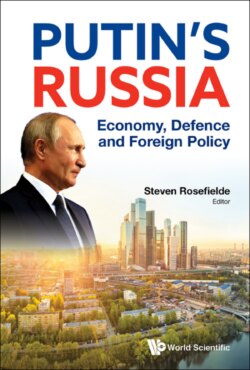Читать книгу Putin's Russia - Группа авторов - Страница 18
На сайте Литреса книга снята с продажи.
Tea Leaves and Productivity
ОглавлениеThe World Bank’s approach to economic crystal ball gazing is congruent with Western tradition, especially the important role assigned to globalisation and TFP. The approach is sensible, but too often misses critical turning points (Rosefielde, 2005b, 2017). The Soviet economy grew rapidly under Stalin’s autarky during the polarised Cold War era of 1955–1968. TFP calculations suggested smooth sailing ahead, encouraging some observers to conclude that planned economy and communism would triumph, but then the USSR fell prey to “growth retardation” driven by a declining marginal capital productivity. The CIA warned about the danger of Soviet secular stagnation (zero growth) in the 1980s; however, it did not take its own warnings seriously in part because Gorbachev pressed market reforms after 1986 and promoted economic integration with the West (globalization). The CIA was shocked when the wheels came off the cart in 1989.
Later, after Boris Yeltsin privatised business property on a freehold basis, encouraged free enterprise and opened Russia’s economy, the catastrophic result took the World Bank entirely by surprise. It expected Russia to recover “up the J-curve” rapidly (Brada and King, 1993), but this never happened. Then, 7 years later when Russia’s economy finally began recovering, the World Bank predicted rosier and rosier futures with Russian GDP advancing at 8% per annum until reality hit. GDP fell 8% in 2008 and never rebounded to the fast growth track.
Obviously, neither globalisation nor TFP have proven to be trustworthy indicators of Soviet and Russian economic prospects. This has multiple explanations beyond exogenous economic and political shocks. Statistical fraud and military concealment stand at the top of the list. The Soviets indulged in a practice called “spurious innovation” where they treated established goods as new ones, raised prices and mischaracterised the price increase as value-added instead of inflation. Inflation increased, but it was disguised as real GDP and hence the term “hidden inflation”.
Much of the per capita income growth claimed by the Soviets was fake (Rosefielde, 2007). The opposite was true for defence. The Soviets and now the Russians understate military activities, especially weapons procurement in their GDP statistics. The World Bank ignores the issue and the impact of military activities on TFP and macroeconomic stability across arms procurement cycles. Russia’s double-digit arms build-up 2010–2015 is invisible in the World Bank’s assessment of Russian economic performance and prospects for harmonious globalisation. Caveat emptor.
